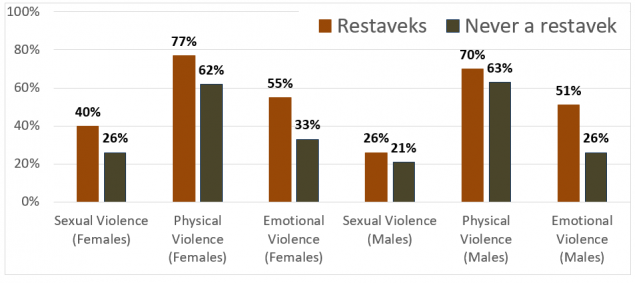Research Brief: Haitian Children who are Domestic Servants are Vulnerable to Violence
Background
In Haiti, child domestic servants who perform unpaid labor are called “restavèks.” Restavèk children typically come from lower- income, rural families who wish to offer their child more opportunity and upward mobility. Usually the child is placed into a higher-income, urban home of either strangers or relatives with the expectation that the host family will provide for the child’s basic needs and pay for the child’s education in exchange for unpaid household labor.
This study described the social and demographic characteristics of restavèks and their experiences of violence during childhood, and determined whether restavèks are more vulnerable to violence in childhood relative to non- restavèks youth. The study used data from the Violence Against Children Survey (VACS), conducted in Haiti with a nationally representative sample of youth (ages 13-24) in 2012. VACS measured violence against children in Haiti, and select questions were included to determine whether youth who had been restavèks experienced more violence in childhood.
Key Findings
- 4% of females and 12.2% of males had been restavèks before age 18.
- Restavèks were more likely to have worked in childhood, have never attended school, and to have come from a household that did not have enough money for food in childhood than youth who had never been restavèks.
- Female restavèks were approximately 2x as likely to experience childhood physical, emotional, and sexual violence compared to non-restavèks.
- Male restavèks were more than 3x as likely to experience childhood emotional violence and approximately 2x more likely to experience sexual violence compared to non-restavèks.
Females and males who had ever been restavèks were more likely to experience sexual, physical, and emotional violence in childhood compared to those who had never been restavèks.

What is added by this report?
This analysis represents the most comprehensive quantitative, nationally representative report on the demographic characteristics of restavèks and their experiences with violence. There has been little research on violence against restavèk children as compared to other children in Haiti. Prior to this survey, there was no national level data on restavèks, so estimates of the number of restavèks ranged from 150,000 to 500,000. This study estimated the number of restavèks at 385,373, which was about 15% of the population of 13–24 year olds in Haiti in 2012. The findings point to the fact that restavèks are significantly more vulnerable to multiple forms of violence than non-restavèk children in Haiti. They live in environments where they are more likely to be victimized and less likely to have protection from violence.
When a catastrophic earthquake hit Haiti in 2010, Dr. Leah Gilbert, now a Medical Officer in CDC’s Division of Violence Prevention, was an emergency medicine resident. Dr. Gilbert used her vacation time to lend her medical skills at a field hospital in a camp for people displaced by the earthquake.
Day after day, she saw a little boy in her emergency room tent who never played with the other children. After asking around, Dr. Gilbert learned that he was a “restavèk”. Restavèk is a term in Haiti for an unpaid child servant. Dr. Gilbert and her colleagues did all they could to make the little boy feel included, playing games in the tent.
“At least in our little tent, he felt like he belonged to something and people cared about how he was doing, even if only temporarily.” – Dr. Leah Gilbert
A few years later, Dr. Gilbert began working with CDC’s Violence Against Children Surveys (VACS). VACS data were collected in Haiti in 2012. From her past experience, she was motivated to learn to use VACS data to understand the experiences of restavèks and whether they are disproportionately impacted by violence compared to other children. Dr. Gilbert’s articleExternal
Gilbert L, Reza A, Mercy JA, Lea V, Lee J, Xu L, Marcelin LH, Hast M, Vertefeuille J, Domercant JW. The experience of violence against children in domestic servitude in Haiti: Results from the Violence Against Children Survey, Haiti 2012. Child Abuse & Neglect 2018; 76: 184-193. https://www.sciencedirect.com/science/article/pii/S014521341730409XExternal
Footnote: some variation between prevalence estimates from published papers and country reports may exist. This variation reflects slight differences in the subsamples and variables used in the analyses.